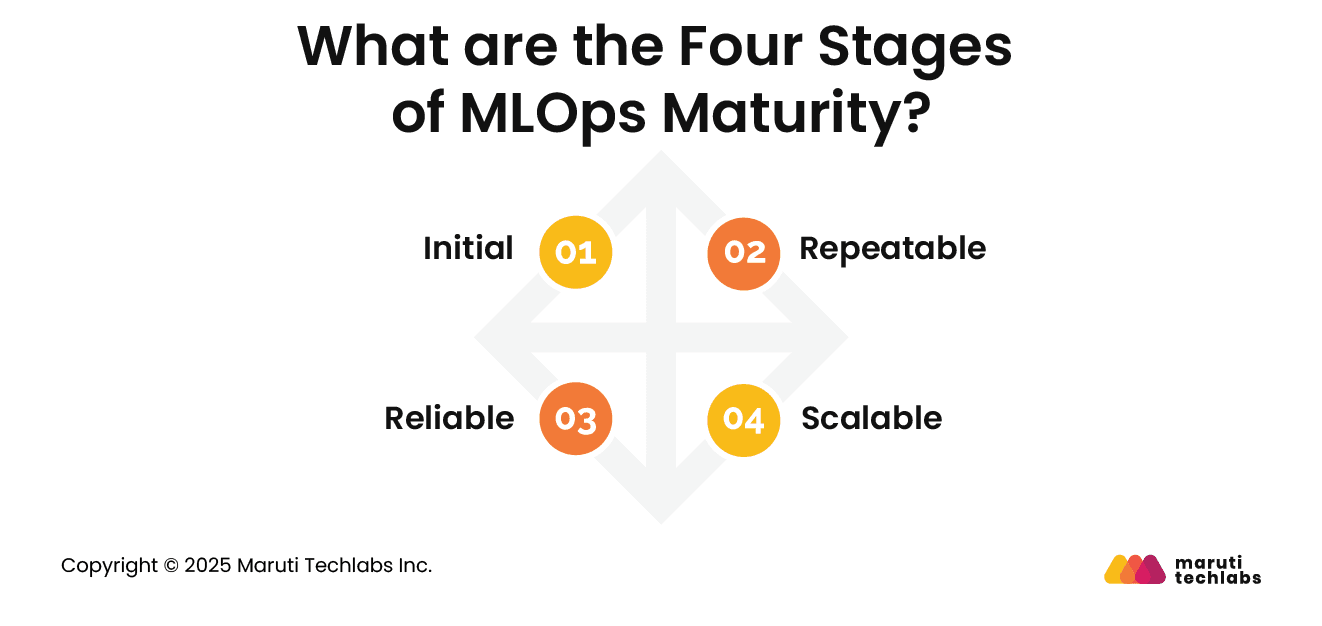

The Ultimate MLOps Maturity Roadmap: Purpose, Barriers, and Tools






Generative AI workloads are exploding from LLMs to image synthesis, driving up cloud usage as organizations train and serve massive models with soaring compute demands.
Traditional security models, however, struggle to keep pace. They were built for static applications, not dynamically evolving AI systems that constantly retrain and adapt. In such environments, old-school defenses fail to address data drift, model retraining risks, or the shared responsibility between data science and operations.
In this blog, we’ll explore the purpose of the MLOps maturity framework, how to evaluate your current MLOps capabilities, identify key barriers, and essential tools that can help you scale safely and reliably.
MLOps Maturity assesses the quality of the capabilities people, processes, and technology possess for deploying and monitoring ML applications in production.
MLOps maturity frameworks serve as strategic blueprints that help organizations move from chaotic, manual ML practices to robust, automated, and scalable operations.
Many organizations follow a unified, vendor-agnostic model to assess their maturity across people, processes, and technology, enabling leaders to benchmark their current state and plan a structured roadmap.
Maturity models also standardize the MLOps lifecycle and clarify the roles, tools, and costs associated with each level.
By defining maturity stages, organizations can align their organizational capabilities, skill investments, and infrastructure to ensure reliable, reproducible, and cost-effective ML deployments, avoiding rework, misalignment, and wasted effort.
MLOps usually develop in steps, and each stage shows how well a team can build and run ML models in real workflows. Let’s explore the four main stages of MLOps maturity.

Many enterprises struggle to scale MLOps due to recurring obstacles that slow progress and limit real-world impact. Here is a list of the critical challenges organizations face in adopting MLOps.
Enterprises struggle with inconsistent, incomplete, and low-trust data that directly impacts model reliability. Missing values, formatting inconsistencies, and duplicates often lead to unpredictable model behavior.
As data distributions shift due to changing customer patterns or external conditions, models degrade silently. Handling both batch and real-time data pipelines further increases complexity, requiring more mature data engineering foundations.
Data scientists often build prototypes in isolated notebook environments, while production systems demand robust, scalable code, creating friction and long deployment delays.
Rewriting experimental code introduces bugs, and mismatches in environments create reproducibility issues. Tracking datasets, artifacts, and hyperparameters across versions adds complexity that traditional DevOps tools aren’t built to manage effectively.
Model performance often degrades gradually due to data drift, feature shifts, or changes in user behavior, making issues hard to detect early.
Traditional monitoring focuses on infrastructure metrics, leaving ML-specific signals overlooked. Without automated retraining workflows, organizations rely on manual intervention, which increases downtime and reduces agility when conditions change.

ML systems must handle fluctuating workloads, from sudden traffic spikes to GPU-heavy training cycles. Static provisioning often leads to over- or under-allocation of resources.
Supporting multi-cloud or hybrid environments adds operational overhead, particularly when models require specialized hardware or compliance-driven data locality constraints, making cost-efficient scaling a core challenge.
Regulations require traceability, explainability, and strict data-handling controls that many ML pipelines weren’t designed to support. Bias and fairness concerns add more pressure, especially in high-risk domains.
Meanwhile, adversarial attacks, data poisoning, and model theft expose security gaps, as traditional security practices rarely address ML-specific vulnerabilities.
Misalignment between data science, engineering, and operations teams slows MLOps maturity. Each group prioritizes different metrics, creating fragmented workflows.
Skill gaps in ML engineering and MLOps tools further impede adoption. Long-established processes and tool preferences often fuel resistance, preventing organizations from shifting to collaborative, standardized ML operational practices.
As organizations advance in their MLOps journey, certain tools become essential for scaling workflows, improving reliability, and supporting mature production pipelines.
MLOps metrics and KPIs serve as a compass for measuring progress throughout the MLOps lifecycle. They offer objective visibility into whether improvements in deployment speed, monitoring, automation, and data management are truly delivering value.
Without well-defined KPIs, organizations risk investing in tools and workflows without understanding their impact on performance, reliability, or business outcomes. Effective KPIs evolve with maturity and must align with organizational goals, not a one-size-fits-all approach.
This dimension tracks how teams adopt MLOps practices, collaborate, and embrace a data-driven mindset.
Metrics here assess alignment between data science and engineering, skill readiness, and the consistency of cross-functional workflows. Improving this dimension ensures teams can scale MLOps practices sustainably.
This focuses on workflow standardization, reproducibility, compliance, and model lifecycle governance.
Measuring aspects such as documentation quality, approval workflows, and auditability helps determine whether processes are shifting from ad hoc to structured, enabling faster and safer deployments.
Technology metrics evaluate the maturity of infrastructure, deployment pipelines, observability, and automation.
These indicators reflect how efficiently the ecosystem supports experimentation, continuous delivery, monitoring, and automated retraining, key elements of advanced MLOps maturity.
At early maturity stages, KPIs establish baselines, such as the number of models in production, providing an initial view of the operational footprint. As organizations advance, metrics become more actionable.
Model deployment frequency and model accuracy on held-out datasets quantify CI/CD efficiency and model quality. At optimized stages, KPIs focus on automation and system robustness: time to detect model drift, infrastructure cost per model, and the number of models automatically retrained.
Business-level KPIs tie MLOps maturity to tangible outcomes, for instance, reduced fraud detection time in financial services or improved click-through rates in e-commerce, highlighting how strong MLOps practices directly translate to measurable business impact.
AI and GenAI are expanding rapidly, and the ability to manage them efficiently is becoming a defining factor for enterprise success. MLOps provides the structure needed to move from scattered experiments to dependable, scalable AI systems that deliver consistent value.
When organizations strengthen collaboration, streamline workflows, and align their tools and practices, they create an environment where AI can grow with confidence.
A clear understanding of your current maturity helps you see where improvements are needed, prioritize the right investments, and accelerate adoption across teams. Building this foundation ensures your AI initiatives are stable, scalable, and ready for enterprise demand.
If you're looking to advance your MLOps capabilities or develop custom AI/ML solutions tailored to your business, we’re here to help. Connect with us to assess your maturity and shape a roadmap that transforms your AI operations into an enterprise-ready capability.


